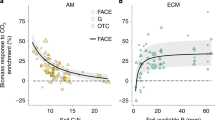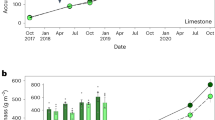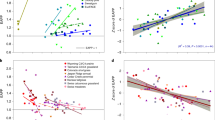Abstract
Rising atmospheric CO2 concentrations can fertilize plant growth. The resulting increased plant uptake of CO2 could, in turn, slow increases in atmospheric CO2 levels and associated climate warming. CO2 fertilization effects may be enhanced when water availability is low, because elevated CO2 also leads to improved plant water-use efficiency. However, CO2 fertilization effects may be weaker when plant growth is limited by nutrient availability. How variation in soil nutrients and water may act together to influence CO2 fertilization is unresolved. Here we report plant biomass levels from a five-year, open-air experiment in a perennial grassland under two contrasting levels of atmospheric CO2, soil nitrogen and summer rainfall, respectively. We find that the presence of a CO2 fertilization effect depends on the amount of available nitrogen and water. Specifically, elevated CO2 levels led to an increase in plant biomass of more than 33% when summer rainfall, nitrogen supply, or both were at the higher levels (ambient for rainfall and elevated for soil nitrogen). But elevated CO2 concentrations did not increase plant biomass when both rainfall and nitrogen were at their lower level. We conclude that given widespread, simultaneous limitation by water and nutrients, large stimulation of biomass by rising atmospheric CO2 concentrations may not be ubiquitous.
This is a preview of subscription content, access via your institution
Access options
Subscribe to this journal
Receive 12 print issues and online access
$259.00 per year
only $21.58 per issue
Buy this article
- Purchase on Springer Link
- Instant access to full article PDF
Prices may be subject to local taxes which are calculated during checkout


Similar content being viewed by others
References
Arneth, A. et al. Terrestrial biogeochemical cycles in the climate system. Nature Geosci. 3, 525–532 (2010).
Rastetter, E. B. & Shaver, G. R. A model of multiple element limitation for acclimating vegetation. Ecology 73, 1157–1174 (1992).
Hungate, B. A., Dukes, J. S., Shaw, M. R., Luo, Y. Q. & Field, C. B. Nitrogen and climate change. Science 302, 1512–1513 (2003).
Oren, R. et al. Soil fertility limits carbon sequestration by forest ecosystems in a CO2-enriched atmosphere. Nature 411, 469–472 (2001).
Schneider, M. K. et al. Ten years of free-air CO2 enrichment altered the mobilization of N from soil in Lolium perenne L. swards. Glob. Change Biol. 10, 1377–1388 (2004).
Reich, P. B. et al. Nitrogen limitation constrains sustainability of ecosystem response to CO2 . Nature 440, 922–925 (2006).
Rastetter, E. B., Agren, G. I. & Shaver, G. R. Responses of N-limited ecosystems to increased CO2: A balanced-nutrition coupled-element-cycles model. Ecol. Appl. 7, 444–460 (1997).
Morgan, J. et al. C4 grasses prosper as carbon dioxide eliminates desiccation in warmed semi-arid grassland. Nature 476, 202–205 (2011).
Donohue, R. J., Roderick, M. L., McVicar, T. R. & Farquhar, G. D. Impact of CO2 fertilization on maximum foliage cover across the globe’s warm, arid environments. Geophys. Res. Lett. 40, 3031–3035 (2013).
Dukes, J. S. et al. Responses of grassland production to single and multiple global environmental changes. PLoS Biol. 3, e319 (2005).
Garten, C. T. Jr et al. Role of N2-fixation in constructed oldfield communities under different regimes of [CO2], temperature, and water availability. Ecosystems 11, 125–137 (2008).
Engel, E. C., Weltzin, J. F., Norby, R. J. & Classen, A. T. Responses of an old field plant community to interacting factors of elevated [CO2], warming, and soil moisture. J. Plant Ecol. 2, 1–11 (2009).
Andresen, L. C., Michelsen, A., Ambus, P. & Beier, C. Belowground heathland responses after 2 years of combined warming, elevated CO2 and summer drought. Biogeochemistry 101, 27–42 (2010).
Derner, J. D. et al. Above- and below-ground responses of C3–C4 species mixtures to elevated CO2 and soil water availability. Glob. Change Biol. 9, 452–460 (2003).
Morgan, J. A. et al. Water relations in grassland and desert ecosystems exposed to elevated atmospheric CO2 . Oecologia 140, 11–25 (2004).
Luo, Y. et al. Progressive nitrogen limitation of ecosystem responses to rising atmospheric carbon dioxide. Bioscience 54, 731–739 (2004).
Gill, R. A. et al. Nonlinear grassland responses to past and future atmospheric CO2 . Nature 417, 279–282 (2002).
Langley, J. A. & Megonigal, J. P. Ecosystem response to elevated CO2 limited by nitrogen-induced plant species shift. Nature 466, 96–99 (2010).
Ainsworth, E. A. & Long, S. P. What have we learned from 15 years of free-air CO2 enrichment (FACE)? A meta-analytic review of the responses of photosynthesis, canopy properties and plant production to rising CO2 . New Phytol. 165, 351–372 (2005).
Adair, E. C., Reich, P. B., Trost, J. & Hobbie, S. E. Elevated CO2 stimulates grassland soil respiration by increasing carbon inputs rather than by enhancing soil moisture. Glob. Change Biol. 17, 3546–3563 (2011).
Lee, T. D., Barrott, S. H. & Reich, P. B. Photosynthetic responses of 13 grassland species across 11 years of free-air CO2 enrichment is modest, consistent and independent of N supply. Glob. Change Biol. 17, 2893–2904 (2011).
Volk, M., Niklaus, P. A. & Körner, C. Soil moisture effects determine CO2 responses of grassland species. Oecologia 125, 380–388 (2000).
Dermody, O., Weltzin, J. F., Engel, E. C., Allen, P. & Norby, R. J. How do elevated [CO2], warming, and reduced precipitation interact to affect soil moisture and LAI in an old field ecosystem? Plant Soil 301, 255–266 (2007).
Norby, R. J., Warren, J. M., Iversen, C. M., Medlyn, B. E. & McMurtrie, R. E. CO2 enhancement of forest productivity constrained by limited nitrogen availability. Proc. Natl Acad. Sci. USA 107, 19368–19373 (2010).
Larsen, K. S. et al. Reduced N cycling in response to elevated CO2, warming, and drought in a Danish heathland: Synthesizing results of the CLIMAITE project after two years of treatments. Glob. Change Biol. 17, 1884–1899 (2011).
Luo, Y. et al. Modeled interactive effects of precipitation, temperature, and [CO2] on ecosystem carbon and water dynamics in different climatic zones. Glob. Change Biol. 14, 1986–1999 (2008).
Reich, P. B. & Hobbie, S. E. Decade-long soil nitrogen constraint on the CO2 fertilization of plant biomass. Nature Clim. Change 3, 278–282 (2013).
McCarthy, H. R. et al. Re-assessment of plant carbon dynamics at the Duke free-air CO2 enrichment site: Interactions of atmospheric [CO2] with nitrogen and water availability over stand development. New Phytol. 185, 514–528 (2010).
Inauen, N., Korner, C. & Hiltbrunner, E. No growth stimulation by CO2 enrichment in alpine glacier forefield plants. Glob. Change Biol. 18, 985–999 (2012).
Reich, P. B. et al. Do species and functional groups differ in acquisition and use of C, N and water under varying atmospheric CO2 and N deposition regimes? A field test with 16 grassland species. New Phytol. 150, 435–448 (2001).
Knapp, A. K. & Smith, M. D. Variation among biomes in temporal dynamics of aboveground primary production. Science 291, 481–484 (2001).
Goward, S. N. & Prince, S. D. Transient effects of climate on vegetation dynamics: Satellite observations. J. Biogeogr. 22, 549–563 (1995).
Hoover, D. L., Knapp, A. K. & Smith, M. D. Resistance and resilience of a grassland ecosystem to climate extremes. Ecology 95, 2646–2656 (2014).
Davis, M. A. et al. Survival, growth and photosynthesis of tree seedlings competing with herbaceous vegetation along a water-light-nitrogen gradient. Plant Ecol. 145, 341–350 (1999).
Harpole, W. S. & Tilman, D. Grassland species loss resulting from reduced niche dimension. Nature 446, 791–793 (2007).
Galloway, J. N. et al. Nitrogen cycles: Past, present, and future. Biogeochemistry 70, 153–226 (2004).
Bala, G., Devaraju, N., Chaturvedi, R. K., Caldeira, K. & Nemani, R. Nitrogen deposition: How important is it for global terrestrial carbon uptake? Biogeosciences 10, 7147–7160 (2013).
Acknowledgements
This research has been supported by the US National Science Foundation (NSF) Long-Term Ecological Research (DEB-9411972, DEB-0080382, DEB-0620652, and DEB-1234162), Biocomplexity Coupled Biogeochemical Cycles (DEB-0322057), Long-Term Research in Environmental Biology (DEB-0716587, DEB-1242531) and Ecosystem Sciences (NSF DEB-1120064) Programs; as well as the U.S. Department of Energy Program for Ecosystem Research (DE-FG02-96ER62291) and National Institute for Climatic Change Research (DE-FC02-06ER64158).
Author information
Authors and Affiliations
Contributions
This experiment was designed and implemented by all three authors; P.B.R. did the analyses and wrote the initial draft; all three authors contributed to editing and revising the manuscript.
Corresponding author
Ethics declarations
Competing interests
The authors declare no competing financial interests.
Supplementary information
Supplementary Information
Supplementary Information (PDF 600 kb)
Rights and permissions
About this article
Cite this article
Reich, P., Hobbie, S. & Lee, T. Plant growth enhancement by elevated CO2 eliminated by joint water and nitrogen limitation. Nature Geosci 7, 920–924 (2014). https://doi.org/10.1038/ngeo2284
Received:
Accepted:
Published:
Issue Date:
DOI: https://doi.org/10.1038/ngeo2284
This article is cited by
-
Irrigation expansion has kept pace with the CO2 fertilization effect on vegetation growth in a typical arid region
Environmental Sciences Europe (2024)
-
Shifts in vegetation activity of terrestrial ecosystems attributable to climate trends
Nature Geoscience (2023)
-
Evidence and attribution of the enhanced land carbon sink
Nature Reviews Earth & Environment (2023)
-
Using tree rings to detect a CO2 fertilization effect: a global review
Trees (2023)
-
Physiological responses to low CO2 over prolonged drought as primers for forest–grassland transitions
Nature Plants (2022)



